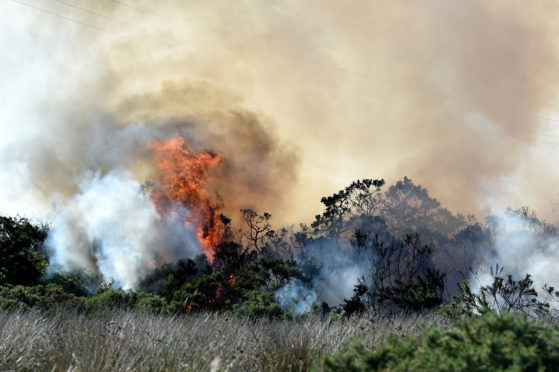The north and north-east is on high alert after a widespread wildfire warning was put in place across large swathes of the region.
The fire service is warning there is a serious risk of blazes in a number of areas due to dry and windy weather.
And crews are poised to react, particularly in south Aberdeenshire and the Western Isles, with the warnings in place until Friday.
A wildfire warning is in place across central and east of Scotland until Friday, March 29.
Livestock, farmland, wildlife and woodland can be devastated – as can the lives of people living and working in rural communities.
Follow our advice ➡️ https://t.co/DcOSIEhSvO pic.twitter.com/A2BMRoQh3a
— Scottish Fire and Rescue Service (@fire_scot) March 25, 2019
The public is being warned to be vigilant, properly dispose of cigarettes and barbecues and ensure campfires are not left unattended.
Wildfires can potentially rage for days and have a devastating impact on land, nature and endanger lives.
In recent weeks, scores of firefighters battled a huge blaze at Culvie Hill, near Banff, after a half-mile stretch of gorse caught fire.
And last month, a massive fire spread to 1640ft by 328ft and raged for 24 hours at Rothiemurchus, near Aviemore.
In 2018, Hopeman and surrounding areas suffered repeated wildfires in tinder-dry conditions.
Bruce Farquharson, local senior officer for Aberdeen and chairman of the Scottish Wildfire Forum, said the fires could have a significant impact.
He said: “Many rural and remote communities are hugely impacted by wildfires, which can cause significant environmental and economic damage.
“Livestock, farmland, wildlife, protected woodland and sites of special scientific interest can all be devastated by these fires – as can the lives of people living and working in rural communities.
“Human behaviour can significantly lower the chance of a wildfire starting so it is crucial that people act safely and responsibly in rural environments and follow the countryside code.
“Grass and wildfires are a common risk at this time of year when warmer weather dries out vegetation – especially dead winter foliage – which offers an ample fuel source.
“Just one heat source like a campfire ember can cause it to ignite and if the wind changes direction even the smallest fire can spread uncontrollably and devastate entire hillsides.”
A combination of leftover dead vegetation, combined with higher temperatures and low humidity makes it easier for fires to be sparked.
For more information about wildfires and how to prevent them, visit www.firescotland.gov.uk.
